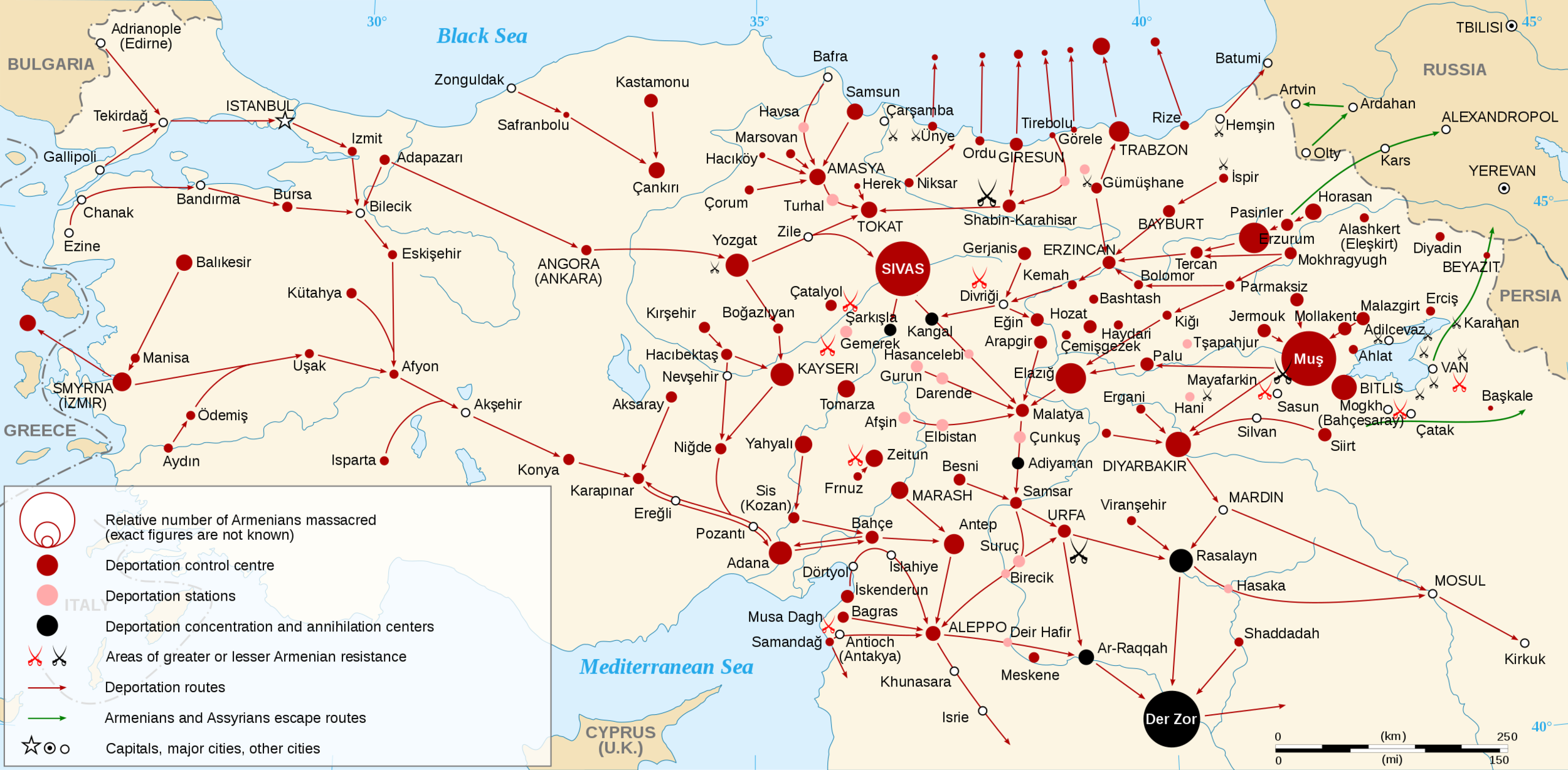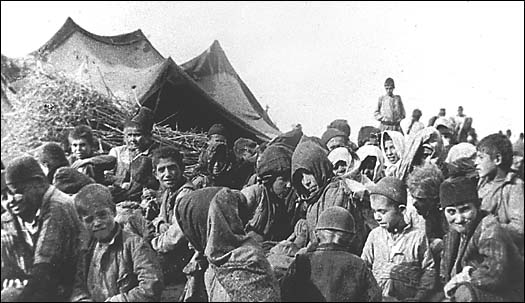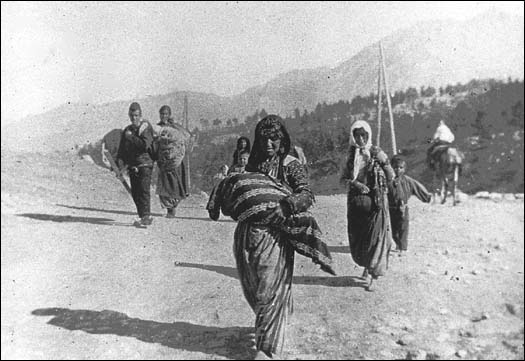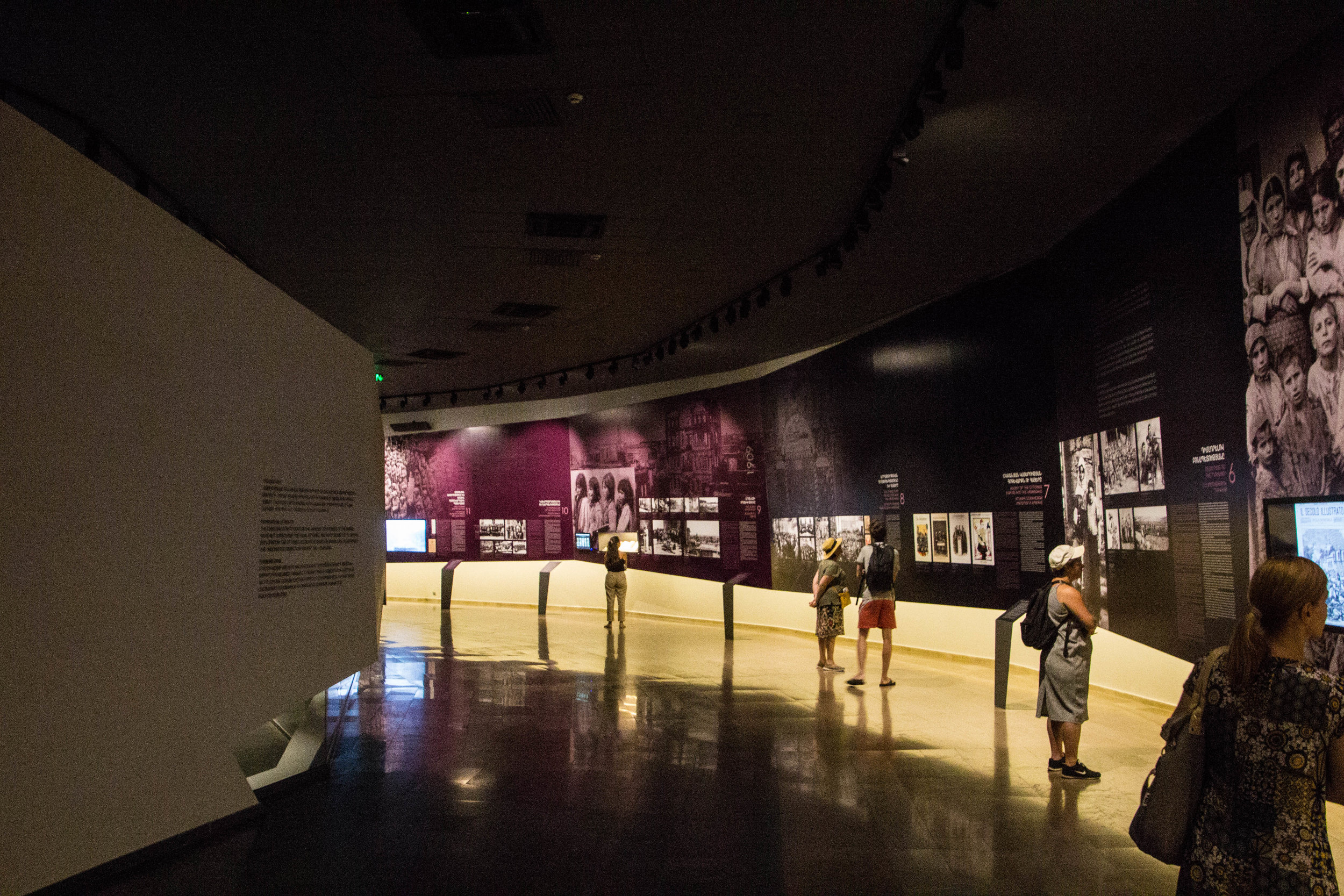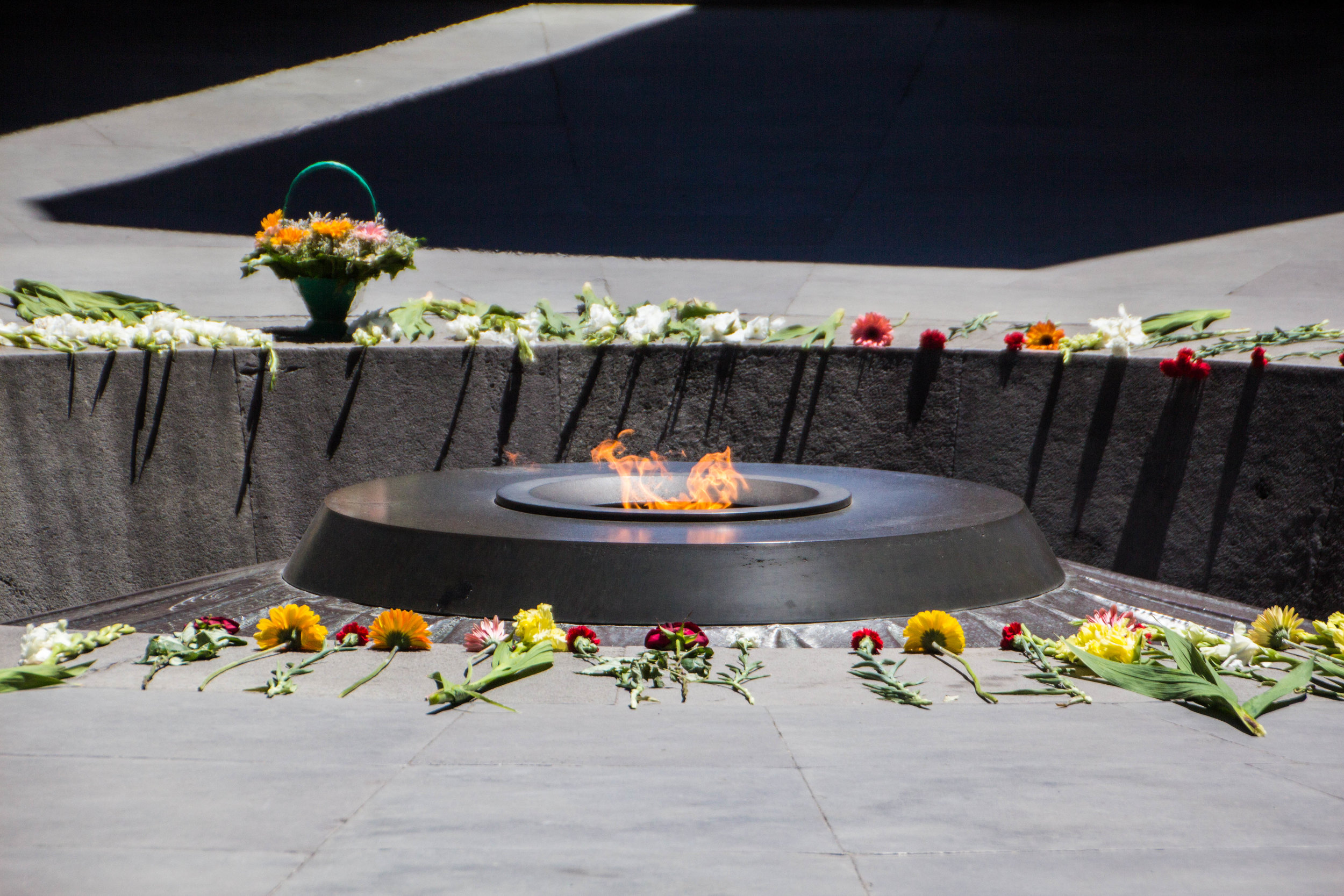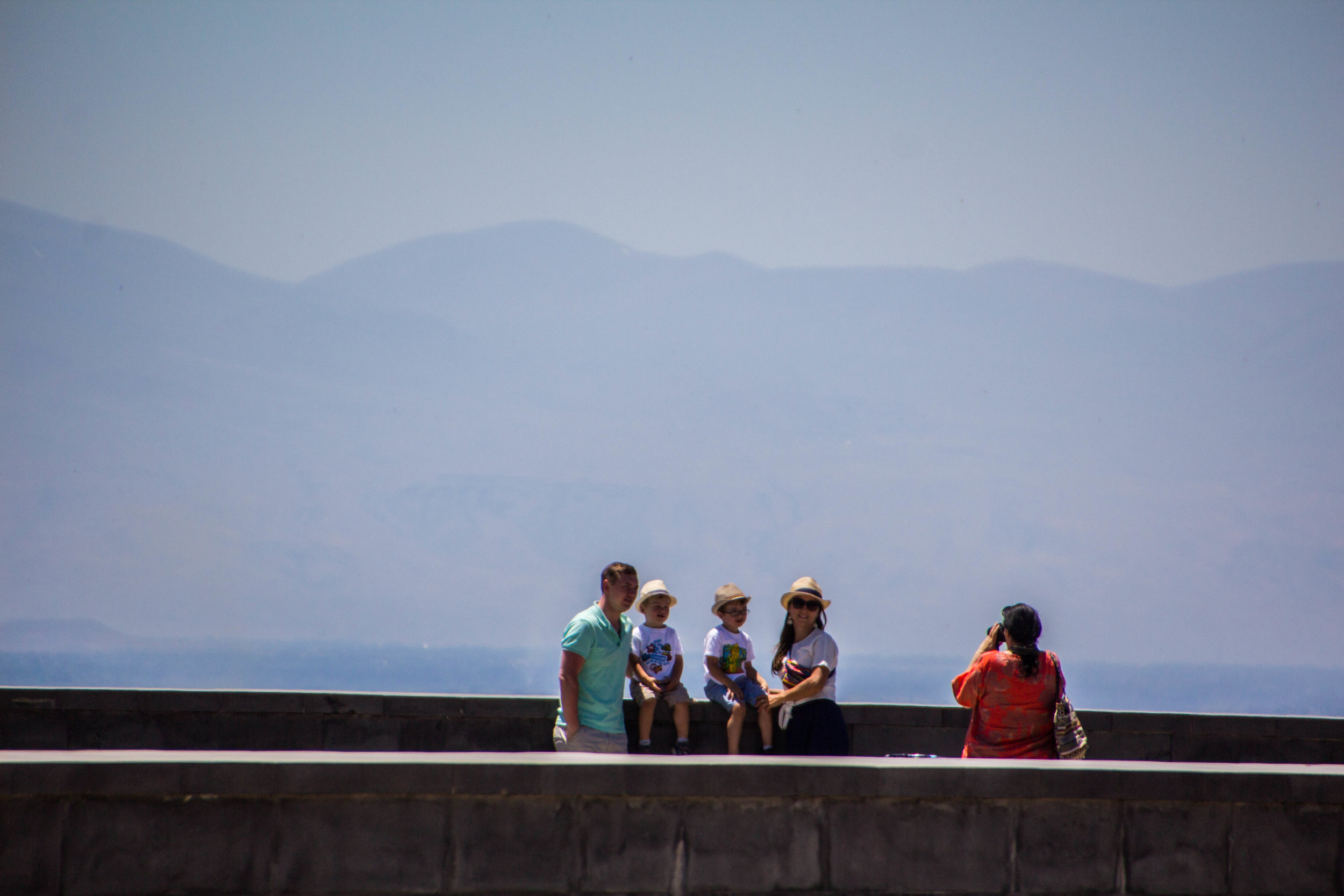This was a big deal. It’s still a big deal even today!
But I’m guessing most of you don’t know much about it. In western 20th century history, the Holocaust pretty much eclipses everything else even in the same ballpark, but what happened in Armenia 30 years prior was extremely consequential as well. In fact, it was this event that prompted the creation of the term “genocide.” There wasn’t really a word for this before the world started to do business with what happened to the Armenians. I’m going to tell you this story now, and I’m sure you will start to notice some eerie parallels with the Holocaust. In fact, the two aren’t entirely unrelated. But before we dive in, I’m going to warn you, this will be disturbing.
🛑 Reader discretion is advised 🛑
Setting The Scene
I should start by telling you that the Armenians are an ancient people. Their history goes back thousands of years farther than we are going to talk about today, so there might be just a bit of context missing here. Any additional context that you might want will likely start in 1555 when Western Armenia came under the rule of the Ottoman Empire. Here’s a quick snapshot of the Ottoman Empire as it was in the distant past so you can get a feel for where this was. But the story that we are about to walk through really starts in the mid-1800s. So we’re going to skip ahead a couple thousand years.
In the mid-1800s, the Ottoman Empire (modern-day Turkey) ruled over Greece, the Balkans, and pieces of Eastern Europe—all of which you will undoubtedly know to be Christian cultures. If you didn’t know, the Ottoman Empire was deeply Islamic, as is modern-day Turkey. Not surprisingly, differing religions put them at odds with many of the peoples that they had conquered, and by the mid-1800s, it had become common knowledge amongst the other European powers that Christians were being treated like total shit inside the Ottoman Empire. Indeed, the Ottomans had long maintained a violent relationship with their non-Muslim citizens. So in the 1830s Great Britain, France and Russia began calls for the Ottomans to end their mistreatment of Christians. Finally, in 1876, the Ottomans passed laws that would guarantee equal rights for all non-Muslim citizens. Sounds like a step in the right direction, wouldn’t you say?
Well it definitely would have been… if it wasn’t for the fact that these laws were largely ignored by people actually living in Ottoman territory. It quickly became apparent that these laws would never be successfully implemented because much of the Islamic Ottoman population fundamentally disagreed with the premise that non-Muslims were equal to Muslims. I’m sure there were exceptions to that… but the history books seem pretty unanimous on that generalization.
Prompted in part by the failure of the Ottomans to implement these laws that would have granted them equal rights, violence and unrest began to break out across the Balkans. At this point the Ottoman Empire was shrinking and widely regarded to be “the sick man of Europe” amongst the other European powers. All the while, the Armenians had been relatively passive through all of this turbulence, even though they were experiencing similar violence and discrimination. They chose, instead, to work within the Ottoman legal system to appeal for their rights. There were administrative victories for the Armenians, but their circumstances and treatment continued to worsen anyway.
What kind of treatment are we talking about here exactly? It varied, but it ranged from being taxed more heavily, to forced conversions to Islam, to stealing, looting, kidnapping, sexual violence, and even murder. And as time went on, Armenian resistance to these practices often resulted in massacres of many Armenians at a time at the hands of the Ottomans. Or, sometimes, these massacres were completely un-prompted. Things were dire. Armenians were beginning to organize into political parties in hopes of bringing about actual change (the picture here is of one such Armenian political movement). But then, as the unrest continued to build, something happened that rocked the world of the Ottoman Empire: revolution!
It had nothing to do with the Armenians. In 1908, a faction of the Ottoman military that would later be known as “The Young Turks” staged a coup and removed Sultan Abdul Hamid II from power. (Yeah, they had Sultans back then.) The aim of this new government was to modernize the Ottoman Empire to be up to par with the other European powers (Britain, France, Russia) against whom they were in competition, as well as bring about political reforms. On paper, this looked like it was going to be a very positive change for the Armenians…
The Armenian Genocide
So here’s the summary of what’s happened so far: The Armenians are being mistreated by the Ottomans, and then there is a revolution, with the Young Turk government taking power. Are you still with me?
Almost immediately, the Balkan War breaks out, wherein the Ottoman Empires loses pretty much all of their European territory. Within the Ottoman Empire, there was a large contingency that viewed this as a punishment from Allah. Soon after, an article was published in a Constantinople (Istanbul) newspaper saying “Let this be a warning ... O Muslims, don't get comfortable! Do not let your blood cool before taking revenge." Meanwhile, there were mass migrations of Muslim refugees out of the Balkans, back into the Ottoman Empire. Most of them ended up having to settle in Armenian territory.
And then WWI breaks out.
WWI & Ottoman Motivations
On November 2, 1914, the Ottomans joined the war, siding with the Central Powers (the Germans, Austro-Hungarians, etc.) Pretty quickly, there are battles between the Russians and the Ottomans happening in the Caucasus mountains. These battles were interesting because large proportions of the soldiers fighting on both sides were Armenians. So the war is already starting to take a toll on the Armenian population. But then things took a turn…
In February 1915, prompted by fears that the Armenians were leaking State secrets to the Russians, and were potentially planning to collaborate with them, the Ottoman military issued Directive 8682, which stated that all Armenian soldiers were to be removed from their posts. Most conscripts were instead switch to laborers, but soon after gangs of Turkish soldiers began to execute them.
The role of pan-Turkism as a motivator for this genocide should also be noted. I don’t want to make it seem like this was just garden-variety racism and paranoia. To get them to enter the war, the Germans promised the Young Turk government an expansion of their eastern border to encompass modern day Azerbaijan. If you have any degree of familiarity with the ethnographic topography of the region, you may know that the Turks and the Azeris are basically the same people. “The Armenian element” was seen as an impediment of the realization of this pan-Turkic ambition, because the Armenians were positioned right in between the Turks and the Azeris. And I should also note that the location of the Armenians had been the same for many thousands of years. This was their ancestral homeland, whereas Turkic peoples had been invaders originating in the Siberia / Mongolia ballpark. Relatively speaking, they were newcomers to the region. Anyways….
That April, the Ottomans demanded that the Armenian city of Van supply them with a few thousand soldiers. However, the people of Van knew about the ongoing executions of Armenian soldiers. They recognized what was actually going on here: the Ottomans were trying to remove and massacre all able-bodied men from the city. So, in an attempt to avert conflict, they offered up 500 men instead, as well a generous sum of money. The Ottoman commanders accused the Armenians of rebellion, and soon after the siege of the city began. 1,500 able-bodied Armenian men grabbed rifles and successfully defended the city’s ~30,000 residents, as well as the ~15,000 refugees who were currently located there, until the Russians came to their rescue. So this installment of the story had a happy ending, but when it came to public opinion of the Armenians, it was the nail in coffin.
The Ottoman propaganda machine had a field day spinning the events of Van as proof that the Armenians were in bed with the Russians (a classic xenophobic tactic), and soon the deportations began. The genocide play-book leaves little room for variation. You start with the intellectuals and the able-bodied men. You want to get rid of anybody who could organize people against you or show resistance to what comes next. And that is exactly what the Ottomans did. Armenian intellectuals in Constantinople and beyond are rounded up and either deported or killed. The massacres of able-bodied men continues town by town, under the guise of being drafted to war, and the events at Van enabled the Ottomans to do much of this in plain sight. Here’s a map showing you where all of this happened. You’ll notice that large chunks of this happen in modern-day Syria and Iraq. Old-Armenian was much bigger than the country we know today, and there were Armenians scattered across this whole region.
Ottoman Atrocities against the armenians
This is where the genocide really gets underway. The New York Times was running stories about these events every week, and there were also German whistleblowers who bore witness to these atrocities and attempted to raise awareness within Germany. But given the gravity of the war that was raging in Europe, the Central Powers with whom the Ottoman had allied themselves gave little protest. They needed the Ottomans to stand with them in the war if they were to stand any chance of winning.
So let’s talk about these “deportations.” That doesn’t sound all that terrible right? I mean, if Germany had just “deported” all the Jews in WWII… I mean, it wouldn’t have been great, but the Nazis would certainly not have gone down in history as having been so incredibly evil. But when the Ottomans used the word deportations, they would round up all the Armenians in a particular settlement, and essentially take them on a death march. Often they would start by separating whatever young men remained and stabbing them to death. Then the helpless women, children, and elders were set off to march into the desert in caravans. Often these deportations happened before the scheduled date, forcing Armenians to leave all of their worldly belongings behind to be immediately looted by their Turkish neighbors. Once the marches were underway, Turkish and Kurdish bands often knew their exact schedules so they could swoop in to rape and slaughter the helpless Armenians. The Ottoman guards that were driving these marches would either stand by while these raids were carried out, or join in and participate in the massacres. During this time, the New York Times continued their reporting, and there is written acknowledgement from German military officials and business leaders as well. The point is that LITERALLY EVERYBODY knew this was happening, friends and enemies alike. I’ll get back to why this is important later.
It’s easy to skip over the atrocities that were committed during this time by simply throwing all of them into the sock-drawer term “massacre,” but what really defined the Armenian genocide was the unimaginable cruelty of the Ottomans. People weren’t just killed. They were tortured in ways that wouldn’t even occur to most people. If you’ve got a weak stomach, you might want to skip the next few paragraphs.
People were mutilated. People had their feet horse-shoed. Children were bayoneted, buried alive, or crushed under horse hooves. Some even had their hair fastened to the back of horses and were dragged to death. There were mass drownings, wherein woman and children were loaded into boats, taken out to sea, and simply thrown overboard. And Italian diplomat who bore witness wrote "I saw thousands of innocent women and children placed on boats which were capsized in the Black Sea." Similar practices were widespread across the region in the whatever body of water was nearest. There were also mass burnings of people who were still alive. The bystanders who witnessed these burnings were traumatized themselves, if not driven mad. It was reported that the smell of burnt flesh would linger in the air for many days afterwards. And there was also smaller but heartbreaking group of Armenian children that were experimented on and killed by Ottoman doctors, who gave them overdoses of morphine, injected them with diseases, and killed them in make-shift gas chambers.
Let’s talk a bit more about how women specifically were treated during all of this. During this time, the Ottoman commanders told their men "do to [the women] whatever you wish." The most disturbing detail I encountered in all of this is that the wombs of pregnant women were used for target practice by Ottoman riflemen. My stomach turned when I read this in Tsitsernakaberd. However, there was also ongoing mass rape and sexual abuse. This often was performed in front of the victims’ families, as this humiliation was intended to horrify and demoralize their communities at large. Victims included women, girls, and some young boys. Deported women were displayed naked in larger cities around the region like Mosul (Iraq) and Damascus (Syria) to be sold off as sex slaves. These women were added to harems, forced to convert to Islam, and often ended up living in captivity for many years after WWI had ended. In Tsitsernakaberd, I read accounts of how these women were still being rescued from captivity as late as the 1950s. To avoid this fate, mothers often took their children and just jumped off cliffs. And one can hardly blame them for doing so.
Many of the photos taken during these events were censored and destroyed, but here are a few of them that survived…
Estimates vary, but when all was said and done, the death toll is widely thought to have been as high as 1.5 million (although some estimates are more conservative. Estimates of the total number of Armenians living in Ottoman territory at the start of the genocide are also a bit scattered, but it’s safe to say that around 88% of all these Armenians died in the genocide. Basically 9 out of 10 people.
Oh, and the Ottomans also did almost everything in their power to erase any evidence of Armenian existence. So we also need to note the cultural loss. Cities, towns, graveyards, churches, art, literature—large quantities of all of the above were destroyed.
Immediate Aftermath
The Armenian Genocide didn’t have an abrupt end like the Holocaust did. The Ottomans were allowed to see their plans for extermination through start-to-finish without impediment. With WWI in full-tilt, rest of the world was pretty much on fire while this was happening. So everybody that could do anything to stop this had bigger fish to fry. The nation that would have had the easiest time of putting an end to these atrocities was Germany, but because they were literally fighting for their life on multiple fronts, they needed to keep the Ottomans happy and on their side. So their leadership cast a blind eye to all of this, even going so far as to censor their own citizens that had traveled to Ottoman territory and documents these horrors. One stand-out case was that of Armin T. Wegner, who was a German soldier stationed in Ottoman Territory during the conflict. Many of the photos above are his.
As the Ottoman Empire fell apart, there were eventually trials held to attempt to hold the people in the Young Turk government that had been the masterminds behind this genocide to account for their crimes. But I’m not going to bother diving too deep into this, because you’ll be disappointed. The basic punchline to the story is that, in all that geopolitical upheaval, they basically got away with it. It wasn’t long before the Ottoman Empire was dismantled by the western powers that had won WWI, and the maps of the entire region were redrawn. The closest I’ve come to hearing about anything even resembling justice was Dan Carlin’s recounting in his excellent podcast “Hardcore History” of how Ottoman leadership was “panicked” when, as the tide of the war was turning against them, they learned of the Allied Powers’ plans to dismantle their empire. Good. Fucking. Riddance.
Of course, the re-drawing of those borders by old white men over drinks on the back of napkins came with its own disastrous set of consequences, which we are still dealing with today, but I get a lot of sadistic pleasure imagining the Young Turk leaders in a panic.
The Armenian Diaspora & Turkish relations
Remember in my last article where I talked about how the Armenian cultural identity is almost omni-present in the modern age because almost everybody now knows an Armenian, and there are famous Armenians all over the place? Well that is only true because so many Armenians were forced to flea their homelands and resettled in other cities around the world. The biggest piece of this was during WWI and the Armenian Genocide, but there have also been other smaller refugee and mass migration events farther back in Armenian history. Collectively, all of this is known simply as “the Armenian Diaspora,” and the numbers are pretty mind-boggling.
Today there are about 11 million Armenians in the world total. Of that total, only 3 million actually live in the country of Armenia. The next top 3 countries that have taken in large numbers of Armenians are Russia, the U.S., and France. It’s no wonder that we’re all so familiar with the Armenian cultural identity.
So how do modern Armenian people relate to modern Turkish people? Well, the old people generally don’t care for one another, but the younger generations have a different stance. For the majority of them, my sense is that they feel like this all happened a long time ago, and that neither group seems to see much good in continued animosity. The page is beginning to turn. However, the Turkish government is another story.
So what does modern-day Turkish State have to say about all this? This is a rock I wish I’d never turned over.
Not only does this genocide remain completely unacknowledged by the Turkish government, but in Turkish schools they actually teach that it was the Armenians who were committing ethnically motivated violence against them. 🤯 Apparently they are also teaching kids that Turkic peoples have always inhabited that region, not the Armenians. I’m a little incredulous that I even still need to treat this as if there is any controversy around it, but that is why, in telling this tale, I’ve been intentional in pointing out how well-documented and ubiquitously agreed upon the facts of this genocide were. This happened.
Now, I’ve been to Turkey. I loved the city of Istanbul and I loved the people I met there, especially the young people. And I stand behind all of this today! Because people are not their governments. I applaud my friends there who are fighting to make Turkey into the forward-thinking nation that we all know it has the capacity to become. Every nation needs people like this, especially America right now! I’ll be the first to admit that even before we all started living in Trump-istan, we had our bloody record of unacknowledged atrocities. My country isn’t perfect in this arena either. So I don’t want to paint a picture to suggest that any meaningful portion of the Turkish public is actively complicit in any of this. Many of them don’t even know it happened. And if they do, there are encouraging stories of attempts at reconciliation by small groups of people. HOWEVER, I’ve also had friends living in Istanbul caution me about publishing this article. Apparently there is some risk that, if the Turkish government realizes I’m not also in denial that the Armenian Genocide ever took place, I could be potentially get banned from ever coming back to Turkey.
I have to admit that this gave me pause. I deliberated. I considered cushioning the message to somehow make Turkey look less bad. I ran scenarios for how being in the bad graces of Turkey could come back to haunt me in the future. But then I realized something.
The mere fact that a random American dude, literally on the other side of the planet, is sitting at home thinking about this stuff is exactly why this story isn’t really over yet. It’s still happening. Turkey is trying to intimidate people like you and me into remaining silent.
Well, here’s what I’ve got to say about that:
VISITING Tsitsernakaberd
THE Memorial & Museum
We’ll shift scene now, to the Tsitsernakaberd Memorial & Genocide Museum in Yerevan, Armenia. People told me that it was an easy walk from the city center, but in the heat of summer, that turned out not to be true. Do yourself a favor, and get a taxi. Trust me.
I’m going to start with the museum. It’s free to enter, and it does a great job of delivering a powerful narrative. It’s an incredibly moving story, and the fact that this museum even exists to share it should be treated as the best outcome that anybody could have hoped for. Who would have thought that after 88% of Western Armenians were murdered, and the rest of the East Armenians were being absorbed into Russia and used to fight one of the bloodiest wars in human history, that less than 50 years later Armenians would be given the platform to tell their own story in this way, even in the face of Turkish denials.
Here are a few snapshots from my time in this museum…
Outside the museum, in the shadow of Mount Ararat, there is the iconic Tsitsernakaberd Memorial. To me, the stark, brutalist style of this architecture seemed to be a theme that was reflected across the broader Armenian architectural style. I gather that what we would call “Armenian architecture” is still a developing story, but I noticed similar elements in many structures around Yerevan.
Here’s a bit about the symbolism here. The tall metal spire on the right (pictured below) represents the national rebirth of Armenia, and the smaller, circular structure next to it is composed of 12 giant slabs that represent the 12 Armenian provinces that have been lost within modern-day Turkey. You see, historically, even in the past 100 years, most of Eastern Turkey was considered to be part of the cultural boundaries of Armenia. Today most remnants that Armenians had ever existed in these areas has been lost, but the people of Armenia will never forget.
Inside the circular structure shown above, there is a flame burning, around which are flowers that have been laid in remembrance. Armenians come from all over the world to pay their respects here. And the day of my visit was no exception. I sat on the stairs leading down towards this flame for a while watching the Armenian families come and go. Many brought their children with them. It was beautiful watching them interact. Many of them distributed the flowers from their bouquets amongst their children, and let them lay the flowers down themselves.
Tsitsernakaberd sits atop a large hill on the outskirts of Yerevan. From the top of this hill, you can see a long ways into the distance, so let me finish with a few pictures of the view looking out from the memorial site. This mountain is a historical symbol of Armenia, but today it is actually located in……… (wait for it)………. modern day Turkey.
On the way back from Tsitsernakaberd, I was riding shotgun in a taxi driven by a fat old man with mostly gold teeth who was smoking a cigarette with his arm out the window. Although he didn’t speak a word of English and I didn’t speak a word of Armenian, he was determined to narrate our drive, pointing out notable buildings as we wound our way back towards central Yerevan. At one point we were driving between two large buildings, which are famous for producing alcohol: the Noy Vodka Factory and the Ararat Congac Factory. Pointing towards the Noy building, he reached between our seats and produced a small bottle of Ararat Brandy. He gestured that I should try it. It was probably ~75% full, but I took a swig. It was fine. I gave him an enthusiastic thumbs up. A partially empty bottle of liquor isn’t exactly what you want your taxi driver to have on him, but I wasn’t mad about it. I was glad for the opportunity to be here. Even from across a language barrier, it was clear that he was super proud of Armenia.
And ya know what? He fucking should be.
Here’s a song from the most famous Armenian-American band, System of a Down. Serj Tankian, the front man of this group, is pretty active in the Armenian community and has emerged as a stand-alone celebrity and solo artist apart from the band. When Bourdain went to Armenia, he spent the whole time with Serj. Anyway, System of a Down does have a song about the genocide (it’s called P.L.U.C.K.) but it’s a little TOO metal for me, so here’s a song I actually enjoy. I hope somewhere Erdogan is within ear-shot of a radio playing these songs.





